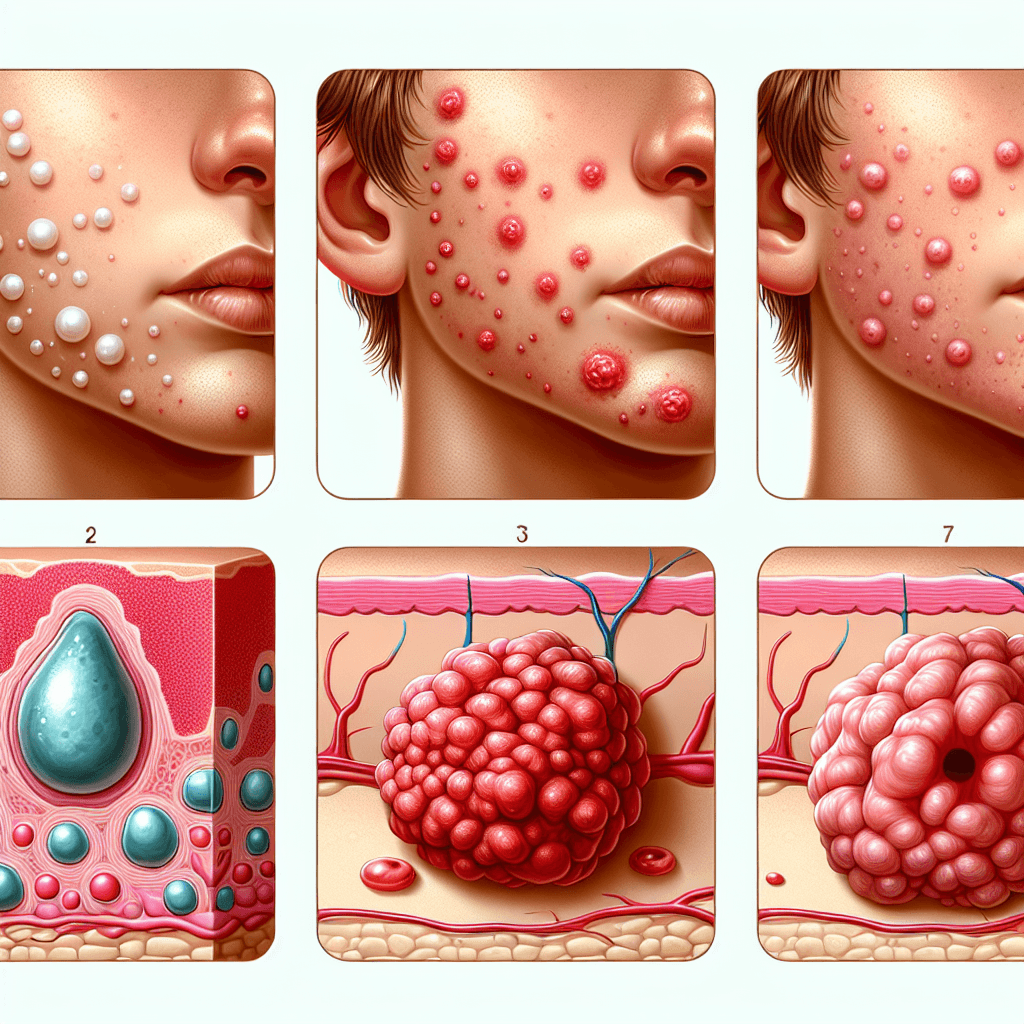Understanding the Signs and Symptoms of Acne
Acne is a prevalent skin condition that affects millions of people worldwide, regardless of age, gender, or ethnicity. While it is most common among teenagers and young adults, acne can persist into adulthood or even develop for the first time later in life. Recognizing the various signs and symptoms of acne is crucial for seeking timely treatment and preventing potential complications, such as scarring or emotional distress.

Types of Acne Lesions
- Whiteheads (Closed Comedones)
- Description: Small, flesh-colored, or whitish bumps on the skin's surface
- Formation: Occur when hair follicles become clogged with oil and dead skin cells
- Texture: Firm to the touch and do not contain pus
- Common Locations: Face, neck, chest, and back
- Blackheads (Open Comedones)
- Description: Small, dark-colored bumps on the skin's surface
- Formation: Develop when hair follicles become plugged with oil and dead skin cells, but the top remains open
- Appearance: Dark color is due to the oxidation of the plug's content when exposed to air
- Common Locations: Face, neck, chest, and back
- Papules
- Description: Small, red, raised bumps on the skin
- Formation: Occur when the walls of hair follicles break down due to inflammation, allowing oil, bacteria, and dead skin cells to penetrate deeper into the skin
- Texture: May feel tender or painful to the touch
- Common Locations: Face, neck, chest, back, and shoulders
- Pustules (Pimples)
- Description: Red, inflamed bumps with visible pus at the tip
- Formation: Develop when inflammation in the hair follicle becomes more severe, leading to the accumulation of white blood cells (pus)
- Texture: Painful and tender to the touch
- Common Locations: Face, neck, chest, back, and shoulders
- Nodules
- Description: Large, solid, painful lumps deep within the skin
- Formation: Occur when inflammation and infection spread further into the skin, affecting the deeper layers
- Texture: Firm and painful to the touch
- Persistence: Can last for weeks or months and may lead to scarring if not treated properly
- Common Locations: Face, neck, chest, back, and shoulders
- Cysts
- Description: Large, pus-filled lesions deep within the skin
- Formation: Develop when inflammation and infection penetrate deep into the skin, creating a cavity filled with pus, oil, and debris
- Texture: Very painful and tender to the touch
- Severity: Considered one of the most severe forms of acne and can cause significant scarring
- Common Locations: Face, neck, chest, back, and shoulders
Severity of Acne
Acne can be classified into three categories based on the type and number of lesions present:
- Mild Acne
- Characterization: Presence of a few whiteheads, blackheads, and possibly a small number of papules and pustules
- Impact: Usually does not cause significant emotional distress or scarring
- Treatment: Can often be managed with over-the-counter products and proper skincare
- Moderate Acne
- Characterization: Higher number of whiteheads, blackheads, papules, and pustules, as well as occasional nodules
- Impact: Can cause emotional distress and may lead to some scarring if not treated effectively
- Treatment: Typically requires prescription-strength topical medications or oral antibiotics
- Severe Acne
- Characterization: Numerous papules, pustules, nodules, and cysts, often leading to significant scarring
- Impact: Can cause substantial emotional distress, low self-esteem, and social anxiety
- Treatment: Requires aggressive treatment with oral isotretinoin or a combination of oral antibiotics and topical medications
Common Areas Affected by Acne
Acne most commonly develops in areas with the highest concentration of oil-producing glands, including:
- Face
- Forehead
- Chest
- Upper back
- Shoulders
However, acne can appear on any part of the body where hair follicles are present, such as the neck, jawline, arms, and even the buttocks.
Psychological Impact of Acne
Acne can have a profound psychological impact on individuals, leading to:
- Low self-esteem
- Social anxiety
- Depression
- Reduced quality of life
The emotional burden of acne can be particularly challenging for teenagers and young adults, who may already be dealing with the pressures of social acceptance and self-discovery. It is essential to address the emotional aspects of acne alongside the physical treatment to ensure overall well-being.
When to Seek Medical Help
If you are experiencing any of the following, it is crucial to consult with a healthcare professional, such as a dermatologist or primary care physician:
- Persistent or severe acne that does not respond to over-the-counter treatments
- Acne that causes significant emotional distress or impacts your quality of life
- Painful, large, or deep lesions that may lead to scarring
- Sudden onset of severe acne, especially if accompanied by fever or other symptoms
A healthcare professional can provide an accurate diagnosis, develop an individualized treatment plan, and monitor your progress to ensure the best possible outcome.
Conclusion
Recognizing the various signs and symptoms of acne is the first step in effectively managing this common skin condition. By understanding the different types of acne lesions, the severity of the condition, and the potential psychological impact, individuals can seek timely treatment and support. If you are struggling with acne, remember that you are not alone, and there are numerous treatment options available to help you achieve clearer, healthier-looking skin.